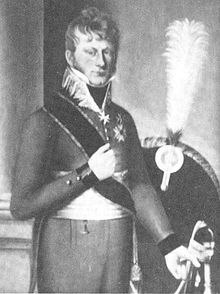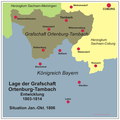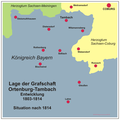Ortenburg-Tambach county

The county of Ortenburg-Tambach , also known for short as the county of Tambach , was a briefly imperial , then a civil county in the Grand Duchy of Würzburg and in the Kingdom of Bavaria . It was located southwest of Coburg and had its seat at Tambach Castle . The county was created through an exchange contract from 1805, with which the former monastery office Tambach was elevated to a county and in return the imperial county of Ortenburg , located in Lower Bavaria , became part of the Electorate of Bavaria . Ortenburg-Tambach existed until the end of the monarchy in Bavaria in 1918.
history
Territorial development of the former monastery office and the imperial county
prehistory
In 1803, the Hochstift Würzburg and the Hochstift Bamberg were secularized as a result of the Reichsdeputationshauptschluss from 1803 . The former Cistercian monastery Langheim of the diocese of Bamberg fell to the Electorate of Bavaria. With the secularization of the mother monastery, the Tambach monastery office with its numerous forests, which extended into the duchy of Saxony-Coburg , came under the control of the Bavarian electors. The electorate acquired the monastery office in 1153, which has been continuously expanded since then, from the Langheim monastery.
In 1801, Imperial Count Joseph Carl, born in 1780, was declared of legal age by Emperor Franz II . He took over from his mother Christiane Louise, née Wild- und Rheingräing zum Stein , the imperial county of Ortenburg , which was highly indebted with more than 200,000 guilders . In order to reduce the expenses of his small domain, he referred his mother, who kept a pompous household, into exile in the nearby Passau and guaranteed her only a small annuity. However, these savings failed to save the county from further major spending. It was evident that with the count's forests and businesses, the count's breweries in Ortenburg and Söldenau and a brick kiln, the tax and trade income of the imperial county and the income from the Bavarian possessions totaling 36,500 guilders annually, the incurred debts were almost impossible to settle. These grew even further to around 254,000 guilders up to 1804. Despite rigorous austerity measures, Joseph Carl could only diminish it a little.
Exchange negotiations
Due to financial difficulties, the young count made the decision to sell the county. In 1803 he approached the imperial vice-chancellor Gundakar von Colloredo-Mansfeld with the intention of selling , which quickly resulted in various negotiations. In the middle of 1803, on the advice of his advisors, Joseph Carl turned to the Bavarian Elector Maximilian IV Joseph and offered him his imperial county for sale. In November of the same year another prospective buyer, Alfred I. zu Windisch-Graetz , was added. He offered his rule Stiekna in Bohemia as an object of exchange for Ortenburg.
Since the end of the Landshut War of Succession and the associated unification of Bavaria , the Bavarian dukes and electors have always seen the small county as an obstacle to a completely closed territorial state of Bavaria. Furthermore, the sales negotiations already taking place had increased the interest of the electors in the Lower Bavarian county, as they were supposed to prevent nobles from around the Habsburgs from acquiring the properties and representing imperial interests in the middle of Bavarian territory. For this reason, the electors pushed the negotiations. These were led by Count Philipp von Arco on the Bavarian side and the Princely Isenburg Council Wolfgang Christian von Goldner on the Ortenburg side. On February 28, 1804, the two had already agreed on a contract, according to which the imperial county of Ortenburg, including all of the Count's-Ortenburg possessions in Bavaria, were to be given to the electorate, and the count was to receive territory in Franconia to be defined in greater detail . The elector assured the young count that he would assume all the debts of his house. Thereupon the counts left Ortenburg and moved to Joseph Carl's father-in-law Count Franz I. zu Erbach-Erbach in Erbach in the Odenwald.
In March 1805, the Bavarian elector presented the former monastery office Tambach and parts of the office Seßlach on the border to the duchy of Saxony-Coburg and Gotha as an exchange object for Ortenburg. From July Goldner and the electoral plenipotentiaries met several times in Munich and an agreement was reached on the future count's possessions and income as well as the legal status of the future County of Tambach. On August 14, 1805, the exchange contract between Elector Max IV Joseph of Bavaria and Count Joseph Carl von Ortenburg was signed. Ortenburg was then assigned a Lower Bavarian market town and the district court of Griesbach , Tambach, however, allodial property of Joseph Carl, endowed with all rights and raised to the empire-direct county of Ortenburg-Tambach.
At the time of the exchange, the Counts of Ortenburg comprised the three quarters of a square mile imperial county of Ortenburg with six villages and approx. 3000 inhabitants as well as the two castles of Alt-Ortenburg and Neu-Ortenburg , as well as the Bavarian possessions around the lordship and castle Söldenau , Ober- and Unter dorfbach , Hirschbach , Buch and the Neudeck estate including Neudeck Castle . In exchange for these goods, Joseph Carl received the newly created imperial county with its seat at Tambach Castle and 18 villages with almost 3,000 inhabitants and extensive forest holdings. According to estimates from 1858, the income from this rule amounted to an impressive 50,000 guilders.
Taking possession and downgrading to class rule
On December 26, 1805, Bavaria ceded the areas around Würzburg in the Peace of Pressburg and received Tyrol and Vorarlberg in return . The areas around Würzburg were given to Grand Duke Ferdinand III. ceded by Tuscany as compensation for his Electorate of Salzburg, the latter went to Austria in return. Würzburg became an electorate. The direct empire county of Ortenburg-Tambach bordered on the newly created Electorate of Würzburg .
On January 20, 1806, the Counts of Ortenburg, who had stayed at the Eulbach hunting lodge in Erbach since they moved in 1804 , moved to Tambach and took over the reign as sovereign there . Joseph Carl made a solemn move into Tambach on February 17, 1806 and accepted the homage of the subjects. However, he could not keep his direct imperial rights for long, because the Holy Roman Empire of the German Nation disintegrated soon afterwards. After Napoléon's victory over Austria, he drove the creation of the Rhine Confederation , which caused the empire to fall apart. Bavaria and 15 other states signed the Rhine Confederation Act on July 12, 1806 and declared their exit from the Reich on August 1, 1806. The act was not only a defensive or offensive alliance , but it also empowered the states to take control of those in their sphere of influence incorporated smaller territories. With the end of the Holy Roman Empire, the county Ortenburg-Tambach lost its raison d'etre and threatened by a media coverage to fall by the Confederation of the Rhine States. For this reason, Joseph Carl turned to the Bavarian Minister Montgelas on August 21 , as he feared the loss of his sovereignty if the Electorate of Würzburg joined the Rhine Confederation. Montgelas tried to allay the count's worries. In September Ferdinand III. joined the Confederation of the Rhine and assumed the title of Grand Duke of Würzburg. A month later, Joseph Carl's fears came true. However, to his own surprise, he did not lose his sovereignty through the new Grand Duke, but rather through Bavaria, which had now become a kingdom . On September 25, 1806, the formerly imperial county was mediatized on the basis of the Rhine Federation Act, downgraded to a civil status with some special rights and assigned to the administrative district of the Mainkreis . In December of the same year Bavaria ceded the authority of Ortenburg-Tambach to the Grand Duchy of Würzburg.
In 1810 there was a state treaty between Würzburg and Bavaria, with which the class rule was divided. Despite protests from Joseph Carl, his possessions were divided up along the Rodach . The eastern part came to the Kingdom of Bavaria, the western part stayed with Würzburg. In 1814 the Rheinbund was dissolved, whereby the Grand Duchy of Würzburg ceased to exist. Due to the Congress of Vienna , most of the Würzburg areas were assigned to the Kingdom of Bavaria. Joseph Carl tried to regain his old rights at the congress, but his attempt with the memorandum on sovereignty oppression failed miserably. This also brought the remaining parts of the noble county of Ortenburg-Tambach back to Bavaria. The rulership was again fully integrated into the Mainkreis as a separate ruling court in Tambach. As compensation for the loss of their sovereignty, Bavaria gave the counts various special rights, including the hereditary title of Imperial Councilor and, in 1827, financial compensation. The former ancestral castle of Ortenburg in their former county was also included in the compensation, which returned to the count's family. As a result of the administrative reforms of the Kingdom of Bavaria , Tambach was subordinated to the Upper Main District in 1817 and to the Upper Franconia administrative district in 1838 . The class rule lasted until the end of the Bavarian Kingdom in 1918.
The family of the Counts of Ortenburg-Tambach still lives at Tambach Castle. Ortenburg Castle was sold by her in 1971.
List of the ruling counts and gentlemen
| Surname | Reign (s) | ancestry |
|---|---|---|
| Joseph Carl | 1806-1831 | Son of Charles III. |
| Franz Carl | 1831-1876 | Son of Joseph Carl |
| Friedrich Carl | 1876-1894 | Son of Franz Carl |
| Franz Carl | 1894-1918 | Son of Friedrich Carl |
literature
- Markus Lorenz: The transition of the county of Ortenburg to Bavaria in 1805. In: Ortenburg - Reichsgrafschaft and 450 years of Reformation (1563-2013) , Ortenburg 2013 (pp. 270–280).
- Markus Lorenz: 200 years of Ortenburg in Bavaria . Lecture on February 17, 2006. Pages 1 to 6 (PDF; 929 kB); Pages 7 to 12 (PDF; 879 kB).
- Walter Fuchs: Ortenburg Castle, Ortenburg monuments and the history of the imperial county of Ortenburg . Ortenburg 2000.
- Markus Lorenz: Ortenburger Geschichtsblätter - The transition of the county of Ortenburg to Bavaria in 1805 , issue 2, Griesbach im Rottal 1997.
- Markus Lorenz: The transition of the county of Ortenburg to Bavaria (1805). Tradition and upheaval in an aristocratic rule , diploma thesis in the degree program Political and Social Sciences, University of the Bundeswehr Munich, Neubiberg 1996.
- Heinz Pellender: Tambach - from Langheim monastery office to Ortenburg'schen Grafschaft - history of the Count's House of Ortenburg, the monastery office and Tambach Castle . 2nd edition, Coburg 1990.
- Friedrich Hausmann : Tambach and the Counts of Ortenburg. In: Weitramsdorf - past and present. 1177-1977. From the story of a village. Weitramsdorf 1977, 276-288.
- Ivo Striedinger : Das Großherzogtum Würzburg , in: ZBLG 6, 1933, pp. 250–256 ( digital-sammlungen.de ).
- Carl Eduard Vehse: History of the German courts since the Reformation - The no German courts. Part ninth. The mediatized. Volume 43, Hamburg 1858, pp. 204-209 ( digitized in the Google book search).
- Johann Gottfried Pahl: National Chronicle of the Teutschen - first half of the year . 1806, p. 124f ( digitized in the Google book search).







